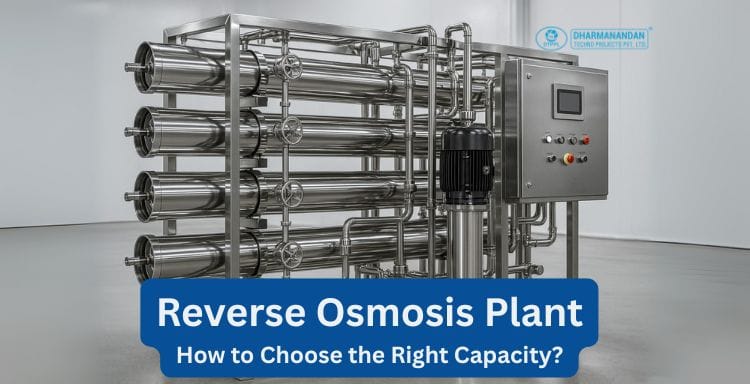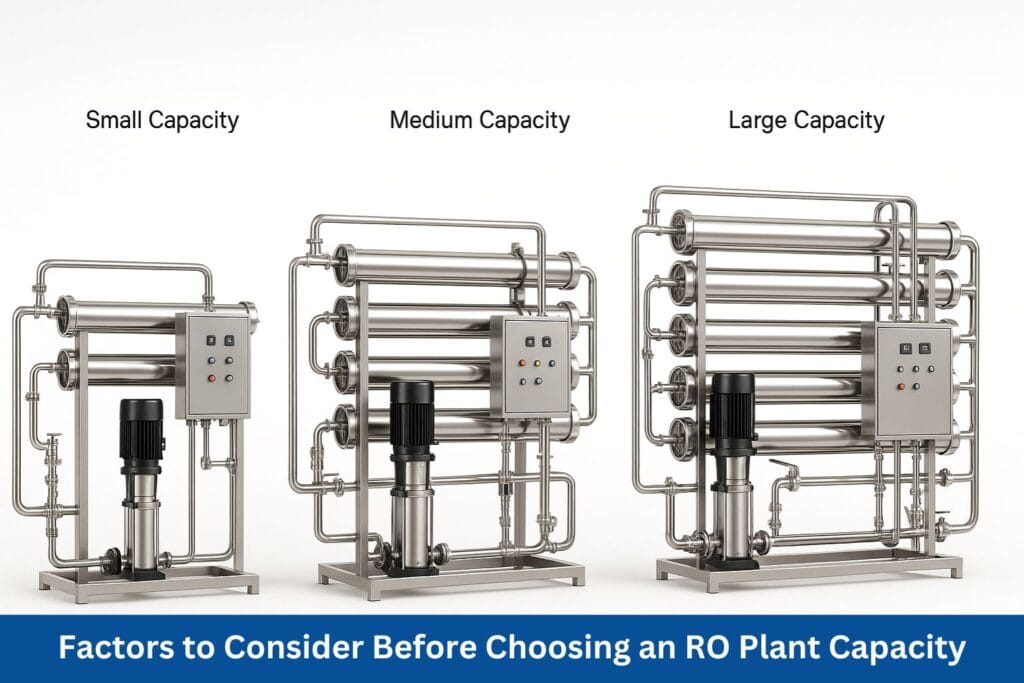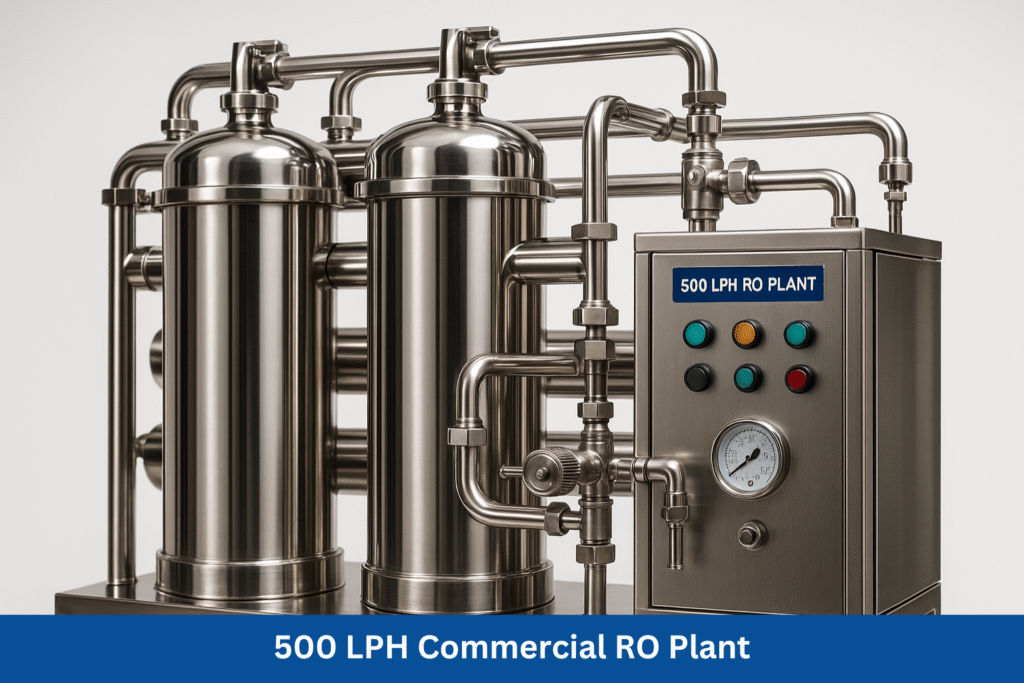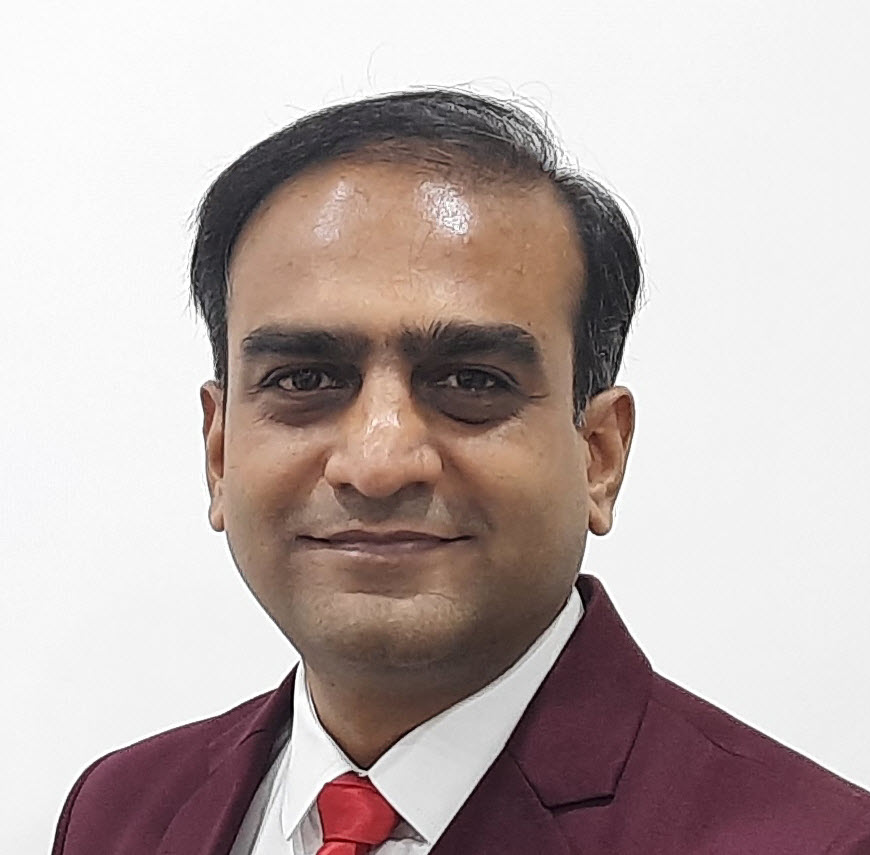
Table of Contents
Reverse Osmosis Plant: How to Choose the Right Capacity?
September 4, 2025
Reverse Osmosis (RO) technology has revolutionized water purification systems, offering businesses a reliable, efficient, and environmentally friendly solution for clean, potable water. Commercial Reverse Osmosis (RO) plants are widely used in various industries to ensure safe, high-quality water for both employees and consumers. Whether you’re a restaurant owner, hospital manager, factory supervisor, or running a retail business, selecting the right capacity RO plant is crucial to maintaining smooth operations and ensuring your water needs are met. This article will guide you on how to choose the right capacity for your commercial needs, focusing on four key capacities: 100 LPH, 250 LPH, 500 LPH, and 1000 LPH.
Why Capacity Matters in Commercial RO Plants
When it comes to choosing the right commercial RO plant, capacity is one of the most important factors to consider. The capacity of an RO system determines how much water the plant can purify within a given period, typically expressed in liters per hour (LPH). Selecting the appropriate capacity ensures that your business has a consistent and sufficient supply of clean water without overburdening the system or leading to unnecessary costs.
Importance of Selecting the Right Size
The size of the RO plant is directly linked to your daily water consumption needs. If the plant is undersized, it will struggle to meet the demand, causing water shortages and disruptions. On the other hand, an oversized plant will result in excessive capital expenditure, higher energy consumption, and unnecessary maintenance costs. A well-sized system optimizes operational efficiency, improves water management, and ensures long-term sustainability.
Risks of Under-Sizing and Over-Sizing
- Under-Sizing: If the RO system cannot handle your required daily water usage, it will lead to frequent breakdowns, water shortages, and system inefficiencies. Under-sized systems also result in low output, which means constant overworking and ultimately a reduced lifespan for the equipment.
- Over-Sizing: Choosing a larger-than-necessary plant might seem like a way to future-proof your operations, but this often leads to over-investment in terms of initial cost, maintenance, and energy consumption. For businesses that don’t require large amounts of purified water, over-sizing wastes resources and lowers overall efficiency.
In short, selecting the correct capacity ensures a balance between demand, efficiency, and cost-effectiveness.

Key Factors to Consider Before Choosing an RO Plant Capacity
Before deciding on the right RO plant size, consider the following factors that directly influence the plant’s requirements:
Daily Water Consumption (Liters Per Day)
The daily water consumption is the most important factor. You must estimate how much water your business requires per day. For instance, a small café might need 300-500 liters, whereas a medium-sized hotel or restaurant could require over 1,500 liters per day.
Number of Users or Employees
The number of people using the purified water also affects the plant size. The more users, the greater the water consumption, so consider how many employees, customers, or residents will need access to the water.
Type of Commercial Establishment
Different commercial establishments have varied water needs. For example, hospitals, factories, and hotels will need significantly more purified water than smaller offices, cafes, or retail shops. Understanding the specific requirements of your industry is crucial in determining the right size.
Quality of Input/Raw Water
The quality of your input or raw water (i.e., water before it enters the RO system) plays a big role in selecting the RO plant. Water with high Total Dissolved Solids (TDS), hardness, or contamination levels will require a larger system or additional pre-treatment systems to ensure effective purification.
Storage and Peak Demand Requirements
In some cases, businesses experience spikes in water demand during certain times of the day. Ensuring that your system can handle peak demand (e.g., restaurant busy hours or factory shifts) is crucial to avoid shortages. Additionally, having sufficient storage capacity is key to maintaining a consistent water supply during peak hours.
100 LPH Commercial RO Plant – Best for Small Setups
Suitable for: Small offices, retail shops, cafés, coaching centers.
The 100 LPH (liters per hour) commercial RO plant is best suited for small-scale establishments with relatively low water requirements. It offers a daily output of approximately 500-800 liters per day, which is ideal for smaller businesses that don’t have a large number of users or high water consumption needs.
Advantages of 100 LPH RO Plant :
- Compact: Its small size makes it easy to install in tight spaces, which is ideal for businesses with limited floor area.
- Cost-Effective: It’s an affordable option for businesses with lower budgets.
- Low Maintenance: The 100 LPH plant requires minimal maintenance and can be operated by a smaller team.
Limitations of 100 LPH RO Plant :
- Limited Output: It may not be suitable for high-demand businesses, as it cannot supply large volumes of water.
- Not Scalable: Businesses that expect growth in water demand may need to upgrade to a larger system in the near future.
250 LPH Commercial RO Plant – Mid-Scale Requirements
Suitable for: Restaurants, schools, gyms, small hotels.
The 250 LPH commercial RO plant is a mid-sized system designed for businesses with moderate water requirements. It offers a daily output of 1,200-1,800 liters per day, which is suitable for medium-sized businesses or establishments with higher water consumption needs.
Advantages of 250 LPH Commercial RO Plant :
- Balanced Efficiency: Offers a good balance between output and space efficiency.
- Affordable: More economical compared to larger systems while providing more water for higher demand.
- Scalable: Can handle moderate growth in demand, especially if you anticipate gradual expansion.
Limitations of 250 LPH Commercial RO Plant :
- Peak Demand: Businesses with highly fluctuating water needs might require additional storage tanks or supplementary systems.
- Space: It requires more space than a 100 LPH plant, which might be a concern for small setups.

500 LPH Commercial RO Plant – Growing Commercial Units
Suitable for: Medium-sized hotels, hospitals, large offices.
A 500 LPH RO plant can handle 3,000-5,000 liters per day, making it ideal for growing commercial units or medium-sized enterprises that require a significant daily water supply.
Advantages of 500 LPH Commercial RO Plant :
- Scalable: This system is highly adaptable and can be expanded with additional storage or filtration components as your business grows.
- High Output: Suitable for larger teams, larger customer bases, or higher volumes of water required for daily operations.
Limitations of 500 LPH Commercial RO Plant :
- Higher Energy Consumption: The 500 LPH plant requires more electricity than smaller systems, which can increase operational costs.
- Space Requirements: It requires more space for installation and proper ventilation.
1000 LPH Commercial RO Plant – Large-Scale Needs
Suitable for: Factories, industrial canteens, large hospitals, commercial complexes.
The 1000 LPH commercial RO plant is designed for high-demand applications where a consistent and substantial supply of purified water is necessary. It provides an output of 8,000-10,000 liters per day, making it ideal for large-scale businesses with substantial water needs.
Advantages of 1000 LPH Commercial RO Plant :
- Consistent Supply: Provides a reliable and steady water supply even during peak hours.
- High-Volume Output: Perfect for factories, hospitals, and large complexes with substantial water requirements.
- Long-Term Investment: Ideal for businesses with long-term expansion goals and significant water consumption.
Limitations of 1000 LPH Commercial RO Plant :
- High Initial Cost: The initial investment for this system is significant compared to smaller units.
- Operational Costs: Higher energy consumption and maintenance requirements make this plant more expensive to operate.
- Professional Maintenance: Requires professional maintenance to ensure optimal performance and longevity.
Cost vs. Capacity: Striking the Right Balance
Choosing a higher capacity RO plant might seem like an easy solution, but it’s essential to strike the right balance between cost and capacity. A higher capacity system involves higher operational costs, including energy usage and maintenance expenses. While these costs may be justified in high-demand settings, they are often unnecessary in smaller businesses. Therefore, assess your daily needs and evaluate ROI to ensure you’re not overspending on excess capacity.
Customization Options in Commercial RO Plants
Many commercial RO plants come with customizable features. These may include additional pre-treatment filters (such as sand or carbon filters) to improve the quality of raw water, UV disinfection integration for added safety, and automation for ease of operation. Skid-mounted systems are available for easier installation, while fixed installations offer a more permanent solution.
Industry-Wise Recommendations
- Offices: 100–250 LPH, depending on the number of employees.
- Restaurants & Hotels: 250–500 LPH, with a larger system for more guests or peak hours.
- Hospitals & Clinics: 500–1000 LPH, due to the higher water demands for patient care and operations.
- Factories & Industrial Units: 1000 LPH or more, based on production needs and employee consumption.
Reverse Osmosis Plant Stainless Steel
Capacity: 1000 LPH to 50,000 LPH
Conclusion: Choosing the Right Capacity for Long-Term Efficiency
Selecting the right capacity RO plant involves considering your daily water consumption, peak demand, water quality, and space availability. Consulting with a professional RO plant manufacturer can provide insights into the specific needs of your business, ensuring long-term efficiency and sustainability. By choosing the right-sized system, you can optimize operational costs, minimize downtime, and ensure that your business has access to a consistent supply of high-quality water.
FAQs: Commercial Reverse Osmosis Plants
1. What is the lifespan of a Commercial RO plant?
The lifespan of a commercial RO plant largely depends on the quality of the system, the frequency of maintenance, and the quality of input water. On average, a well-maintained commercial RO plant can last 10 to 15 years. Regular maintenance, such as changing filters and membranes, can extend the lifespan.
2. How often do I need to replace the RO membranes?
RO membranes typically need replacement every 1 to 3 years, depending on the quality of the raw water, frequency of use, and the type of membrane. If the TDS (Total Dissolved Solids) in the raw water is high, membranes may wear out faster, requiring more frequent replacement.
3. Can a Commercial RO plant be installed outdoors?
Yes, many commercial RO plants can be installed outdoors, but it’s crucial to ensure that the system is protected from extreme weather conditions. Outdoor installation often requires additional weatherproofing or a shelter to protect the system from rain, direct sunlight, and temperature extremes.
4. Is water wastage a concern in Commercial RO plants?
Yes, water wastage is a natural byproduct of reverse osmosis. Typically, for every 1 liter of purified water, 2-3 liters of water are rejected as waste. However, newer technologies and water recovery systems can reduce this waste. Some systems can recover up to 50-75% of the input water, making them more water-efficient.
5. Can I use a Commercial RO plant for drinking water in my business?
Yes, Commercial RO plants are designed to purify water to make it safe for consumption. They effectively remove harmful contaminants such as bacteria, viruses, heavy metals, and other impurities, making the water safe for drinking. However, in some cases, additional post-treatment like UV sterilization may be recommended to ensure 100% purification.
6. Do I need to install a water softener before the RO plant?
If your raw water has high hardness (i.e., high levels of calcium and magnesium), it is advisable to install a water softener before the RO system. Hard water can cause scaling on the RO membranes, reducing their efficiency and lifespan. A water softener will help prevent this issue.
7. How much electricity does a Commercial RO plant consume?
The electricity consumption of a commercial RO plant varies depending on its capacity and the level of water purification required. On average:
- 100 LPH plants consume around 0.5-1 kWh of electricity per day.
- 500 LPH plants consume approximately 2-3 kWh per day.
- 1000 LPH plants may consume 4-6 kWh per day.
This can vary based on the efficiency of the system and whether additional features like UV sterilization are integrated.
8. Can I scale my RO system if my water needs increase?
Yes, many commercial RO systems are designed to be scalable. You can expand your existing system by adding additional modules or storage tanks to meet increased water demand. However, it’s important to consult with an RO manufacturer or technician before upgrading to ensure the system is adequately configured.
9. Is it necessary to have a storage tank with a Commercial RO plant?
Yes, a storage tank is typically necessary for commercial RO systems, especially for businesses with varying water demands throughout the day. A storage tank allows the system to store purified water for later use, ensuring a continuous supply even during peak hours. The size of the storage tank depends on your daily water usage and peak demand.
10. Can I install a Commercial RO plant myself, or do I need a professional?
While some small-scale systems might be simple to install, it’s generally recommended to hire a professional installer for larger commercial systems. A professional can ensure proper installation, including the correct placement of filters, membranes, and other components, and ensure that the system meets the necessary water quality standards.
11. How does the TDS of raw water affect the choice of RO plant?
The Total Dissolved Solids (TDS) in raw water greatly influences the capacity and efficiency of the RO system. Water with higher TDS levels will require a more powerful RO plant to effectively purify the water. In such cases, additional pre-treatment, such as a water softener or carbon filter, may be needed to protect the RO membranes from scaling and clogging.
12. Can a Commercial RO plant remove all types of contaminants?
While RO plants are highly effective at removing most contaminants such as salts, heavy metals, bacteria, and viruses, they may not be as effective at removing volatile organic compounds (VOCs) or certain chemicals. Additional treatment like UV disinfection, activated carbon filters, or ion exchange systems may be necessary for a complete purification process.
13. What kind of warranty is provided with Commercial RO plants?
Most commercial RO systems come with a warranty ranging from 1 to 3 years on the machine itself. The warranty typically covers manufacturing defects, and some may include maintenance for a certain period. Be sure to check the details of the warranty provided by the manufacturer or supplier, especially for the membranes, filters, and other critical components.
14. How much does a Commercial RO plant cost?
Since prices vary depending on several factors like brand, additional treatments (UV, pre-filters), and installation costs, it’s best to consult Dharmanandan Techno Projects Pvt. Ltd. for an accurate quotation based on your specific requirements and site conditions.
15. What factors influence the cost of a Commercial RO plant?
The main factors influencing the cost of a commercial RO plant include:
- Capacity (LPH): Larger plants are more expensive.
- Water Quality: If the raw water contains high levels of TDS or contaminants, additional pre-treatment systems might be needed, increasing the overall cost.
- Customization: Features such as UV sterilization, automation, or integration with existing water storage systems can raise the cost.
- Brand and Quality: Premium brands with higher-quality components will generally cost more.
For precise pricing tailored to your needs, contact Dharmanandan Techno Projects Pvt. Ltd., who can provide a detailed quote based on the water quality and capacity requirements of your business.
16. What is the maintenance cost for a Commercial RO plant?
The maintenance cost of a commercial RO plant depends on its size, usage, and the water quality. This typically includes the replacement of filters, membranes, and periodic servicing. For an accurate estimate of maintenance costs for your RO system, it’s advisable to consult with Dharmanandan Techno Projects Pvt. Ltd., who offer detailed maintenance plans and service agreements.
About Author

Director – Global Marketing and Sales
Mr. Bhavesh from Dharmanandan Techno Projects Pvt. Ltd. has played a pivotal role in elevating the DTPPL brand to the global stage, leveraging his exceptional expertise in marketing and communications. He is committed to helping clients achieve significant growth while strengthening their own brands. Dharmanandan Techno Projects Pvt. Ltd. is a leading manufacturer and supplier of water purification systems and turnkey solutions for mineral water plants. With years of experience in designing and delivering high-quality water treatment solutions, the company provides end-to-end services, including system design, installation, maintenance, and ongoing support. Specializing in scalable and customizable water plants, DTPPL has successfully served industries worldwide, ensuring clean and safe drinking water across diverse applications.




